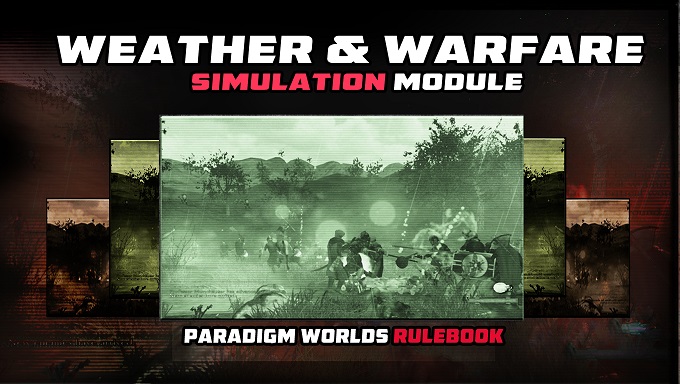
WEATHER & WARFARE Simulation Module - RULEBOOK
This article explains the mechanisms of the 'engine' that runs battles in Paradigm Worlds.Its aim is to bring realism to battle. The Weather & Warfare Module (W&W) is a code that improves vanilla Mount and Blade in several ways.
Table of Contents
PART I - Troops and Agents
PART II - On Battle
PART III - The Code - Weather Module
PART IV - The Code - Warfare Module
- PHASE 1. Personal skill modifiers
- PHASE 2. Leader's skill modifiers
- PHASE 3. Division modifiers
- PHASE 4. Item Quality modifiers
- PHASE 5. Microchip Modifiers
PART VI - Paradigm Worlds settings and tweaking options
PART VII - Damage dealing techniques
PART VIII - Critical Hits
PART IX - Appendix
PART I - Troops and Agents
What happens when a player enters a battle?
Troops that appear on the battlefield are called Agents. Agents are variations of troops - copies, or avatars if you like. Troops can have multiple items in their inventory. Just like the player, they can 'have' multiple weapons, armors and so on. Troops can have up to 64 items in their 'invisible' inventory.
Agents have only 4 weapon 'slots', and relevant slots for armor, helmet, gloves, boots. So, if troops can have 4 different armors in its inventory, it means that the agent will have at least 4 variations.
There is a very good description made by Lav, which sheds some light on this subject. Maybe his explanation is easier to understand:
"An agent represents a single soldier on the 3D scene. Always keep this in mind when dealing with regular troops. A party may have 30 Swadian Knights. They will form a single troop stack in the party, and they will all be copies of the one and only Swadian Knight troop. However when the battle starts, this stack will spawn 30 distinct Agents.
Agents do not persist - they only exist in the game for the duration of the mission. As soon as the player returns to the world map, all agents who were present on the scene immediately disappear. If this was a battle during a normal game encounter, then the game will keep track of the battle results, and depending on the number of agents killed from all sides the engine will kill or wound some troops in the troop stacks of the parties who were participating in the battle."
Agents do not persist - they only exist in the game for the duration of the mission. As soon as the player returns to the world map, all agents who were present on the scene immediately disappear. If this was a battle during a normal game encounter, then the game will keep track of the battle results, and depending on the number of agents killed from all sides the engine will kill or wound some troops in the troop stacks of the parties who were participating in the battle."
There is one more difference between troops and agents. Troops, for example the Player, are described by attributes (strength, agility, etc) and skills (power strike, athletics, etc). Agents are described by the following variables:
- Speed - How fast the agent moves
- Accuracy - Ranged weapons accuracy
- Ranged Damage
- Melee Damage
- Reload speed
- Health Points (HP)
In Paradigm Worlds, these variables together are what's known as 'Battlefield Efficiency'
There are two more important variables:
- Courage/Morale - Measured in Morale Points
- Mount Speed - The agent's modifier based on the 'riding' troop skill
When troops are being transformed into agents, all variables are used for the described troop are 'translated' into variables that describe the agent. In essence, the Weather & Warfare module can be summed up as "a unique, complex way of translating troops into agents."
PART II - On Battle
If you are interested only in plain numbers, you can skip this section. This largely serves to explain Grodecki's way of thinking, and to show how accurate a system he's tried to create.
What affects the efficiency of a soldier on the battlefield? This is the question Grodecki asked himself when he was planning his simulation.
- Weather?
If we look back on the history of Napoleon's war with Russia, or the Nazis' failed raid on Soviet Russia, we can see the impact the weather has on war. But weather conditions can be broken into smaller, more focused parts. What is weather in terms of warfare?
- Temperature - Can impact troop performance
- Clouds/Haze - Can affect visibility
- Snow/Rain - Can affect willingness to fight, accuracy
These conditions depend on the season: Winter is harsh. Warm sunny days are much better for waging a war. In Paradigm Worlds, seasons affect all weather conditions.
- Terrain - It is easier to fight on plain land than in the forest.
- Weight - How much does a soldier have to carry? How tiring can it be? How will it affect their Battlefield Efficiency?
- Quality of Equipment - Naturally, an old musket, cracked bow, or rusty armor can change the outcome of a battle.
- Division - A simple soldier cannot handle a cannon, and a trained sniper should have better accuracy than, for instance, a marine. In Mount & Blade, the player can 'link' troops to certain divisions like Infantry and Cavalry and so on. Grodecki believes that divisions represent a certain way of training.
- Microchips - Instead of cyborg augmentations, Paradigm Worlds offers a feature of special items that improve certain battlefield skills. Details regarding Microchips can be found here.
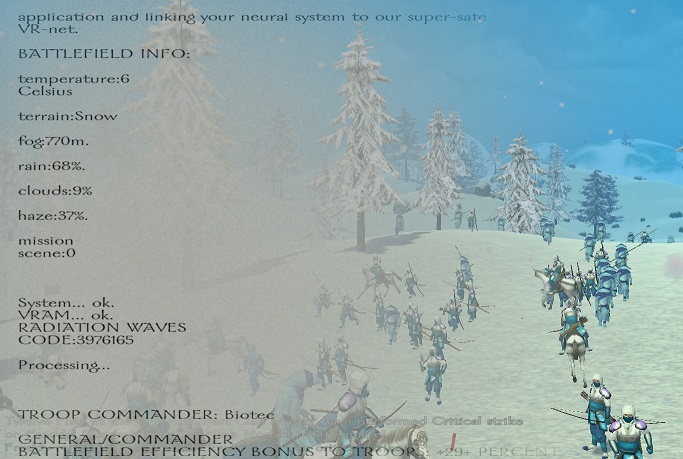
PART III - The Code - Weather Module
Every 24 hours, a general weather situation is simulated. It is based on season (spring, summer, autumn, winter) and terrain (water, mountain, steppe, desert, snow, forest, etc.). Every 3 hours this 'base' weather changes to reflect changing conditions. In other words, there is a main-weather-script (24h) and a sub-weather-script (3h).An example: If you move from a snowy forest to a hot desert, every 3 hours the temperature will rise. Even the difference between day and night affects the weather.
Battle begins. The Weather Module fires up. It transfers information from the Weather report to the battlefield:
- Rain Type - Can be rain or snow.
- Rain Force - How hard is the rain falling? Is it a drizzle or a storm?
- Cloud Force - If rain-force is bigger than cloud-force, then it will rain or snow.
- Haze Density - How thick is the fog?
- Fog Distance - How close to the player's view is the fog?
- Temperature - Self-explanatory.
What affects an agent's efficiency as calculated by the W&W Module?
A) WEIGHT
Equipment weight affects more than just an agent's speed. Total weight is calculated, then it is reduced by the Bodybuilding skill by 5kg per skill point. 15 points of Bodybuilding "reduce" weight by 75kg.
NOTE: Maximum equipment weight is 300kg. Any weight above this is still treated as 300kg.
Negative effect to speed = equipment weight / 4 = UP TO 75%
Negative effect to efficiency = equipment weight / 8 = UP TO ~38%
B) TERRAIN
Each kind of terrain affects an agent's speed and efficiency. This is self-explanatory enough. Some examples:
Steppe: +5% speed, +5% efficiency
Water: -5% speed, -10% efficiency
Snow: -30% speed, -20% efficiency
C) DAY/NIGHT
The following bonuses apply for Battlefield Efficiency:
Day: +20% - Night: -5%
D) TEMPERATURE
Ideal temperature is 21 degrees celcius.
In the event of ideal temperature, agents get +15% to efficiency. If the temperature is 16-26 degrees celcius, all agents get +10% to efficiency.
For each point below 16c, agents lose 1% efficiency
For each point above 26c, agents lose 1% efficiency
E) ATMOSPHERIC CONDITIONS
Rain type, rain force, cloud force, haze density and fog distsance can all reduce efficiency. They are calculated together.
Maximum negative effect: -40% to efficiency.
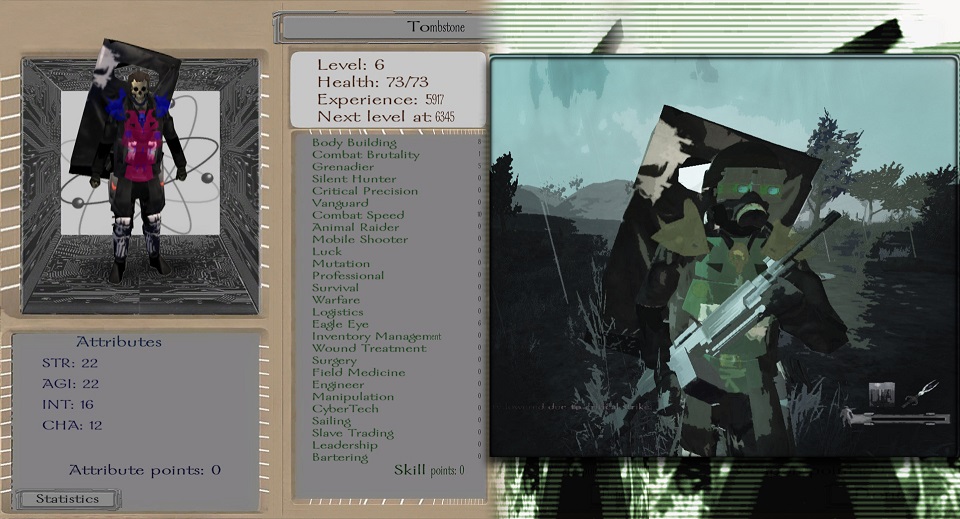
PART IV - The Code - Warfare Module
The Warfare Module's aim is to simulate battle in detail, and to bring a deeper RPG flavor to encounters.
First, let us point out the difference between 'old vanilla' and the new Warfare Module. In vanilla, there were skills that didn't matter in battle and only affected the world map. For example, Spotting defined how far you see on the world map, and was useless when it came to a battle.
To simulate the battlefield, Paradigm Worlds makes use of almost every skill. There are three possible troop skill categories:
Party - The game engine chooses party characters with the highest skill, for example in Logistics (formerly Pathfinding), so you don't have to pump that skill up yourself. You can train one of your companions to be your scout.
Personal - Combat Brutality, for example, is important only to a single character, defining melee damage and not affecting events on the world map.
Leader - Leadership, for example, is important only if you are commanding your own army, and has no effect if you're just a grunt in someone else's.
In Paradigm Worlds, skills do have significant impact on the battlefield. They do more than just one thing, and some skills work as Party and Personal skills simultaneously.
Example of a combined Party and Personal skill:
Eagle Eye (formerly Spotting):
PERSONAL: Improved ranged accuracy on the battlefield. Must-have for a sniper.
PARTY: Party seeing range is increased by 10% per skill level. +1% to world map speed.
Party/Personal Skill
To explain in the most simple manner how the W&W Module calculates Agents' efficiency: It is divided into "PHASES":
PHASE 1. Personal Skill Modifiers
a) MOUNTS
Each mount has its own speed and agility (how fast it can turn). These valuse are modified by the agent's 'driving' skills. This is how the Warfare module calculates the 'driving' skill:
Battlefield Efficiency + Speed / 2 = base mount speed
Base mount speed can be improved by 5% for every point of Animal Riding (max 15 points) and by 3% for every point of Mobile Shooting (max 15 points).
b) MELEE DAMAGE
Combat Brutality - Each point improves Damage by 5%.
Professional Each point improves Damage by 3%.
c) ACCURACY
Eagle Eye - Each point improves Accuracy by 5%.
Professional - Each point improves Accuracy by 3%.
Critical Precision - Each point improves Accuracy by 1%.
Automatic weapons, like machine guns, suffer from recoil that lowers their accuracy. Recoil is reduced by the Grenadier skill.
d) BATTLE HEALTH
Troops' health modified by the Warfare Module is called Battle Health. Battle Health represents not just vitality, but also willingness to fight and live, "power of will" in other words. This is why it is higher than base health.
In numbers, Battle Health is Health modified by the following skills:
Bodybuilding - Adds 3% Points to BH.
Professional - Adds 2% Points to BH.
Vanguard - Adds 2% Points to BH.
Survival - Adds 5% Points to BH.
In addition, each level adds 2 points to BH. Level 30 troops get +60% BH Points.
There is also a special rule that makes lords and kings more vital. It does not apply to players.
Lords - BH is doubled and +50 Points are added.
Kings - BH is tripled and +100 Points are added.
PHASE 2. Leader's Skill Modifiers
Each army has its leader. It can be a hero, like a Lord or the player, or a regular troop.
Leader skills improve the abilities of all units in the army.
Skills and modifiers:
Professional - Each point improves agents' Battlefield Efficiency by 1%.
Leadership - Each point improves agents' Battlefield Efficiency by 1%.
Manipulation - Each point improves agents' Battlefield Efficiency by 1%.
Warfare - Each point improves agents' Battlefield Efficiency by 1%.
Field Medicine - Each point improves agents' Battle Health by 3 points.
PHASE 3. Division Modifiers
Divisions represent specific ways of training troops. They apply small but important bonuses. At the party screen, you can allocate each troop to one of the divisions listed below.
- INFANTRY: Health +20%
- RANGED: Accuracy +25%
- CAVALRY: Mount Speed +15%, Melee Damage +5%, Morale +60%
- SHOK: Melee Damage +12%, Morale +40%
- COMMANDOS: Speed +15%, Reloading +15%
- ENGINEERS: Speed +10%, Reloading +75%, Item Use Speed +75%
- MONSTERS: Health +10%, Speed +5%, Morale +99%
- ALL OTHER DIVISIONS: Battlefield Efficiency +5% (Health, Speed, Reload etc.)
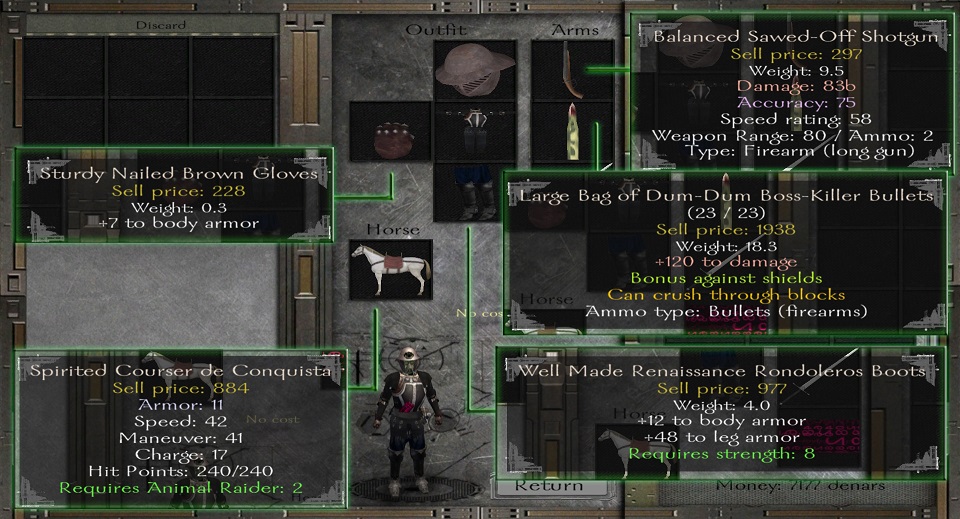
PHASE 4. Item Quality Modifiers
Item Quality is described by names like 'strong', 'heavy', 'cracked', etc.
Item Quality Modifiers apply only to agents representing heroes, like players, companions, lords, kings, or bosses.
Each item modifier affects a hero's Battlefield Efficiency. These modifiers can be positive or negative. That's why it's important to look for good quality items - sometimes it's better to wear high-quality low-tier armor than a cracked set of high-tier equipment.
Item Quality Battlefield Efficiency
Plain:
0.00%
Cracked:
-10.00%
Rusty:
-6.00%
Bent:
-6.00%
Chipped:
-4.00%
Battered:
-4.00%
Poor:
-3.00%
Crude:
-2.00%
Old:
-1.00%
Cheap:
0.00%
Fine:
2.00%
Well Made:
3.00%
Sharp:
3.00%
Balanced:
3.00%
Tempered:
3.00%
Deadly:
5.00%
Exquisite:
12.00%
Masterwork:
9.00%
Heavy:
3.00%
Strong:
4.00%
Powerful:
5.00%
Tattered:
-3.00%
Ragged:
-4.00%
Rough:
1.00%
Sturdy:
1.00%
Thick:
2.00%
Hardened:
3.00%
Reinforced:
5.00%
Superb:
7.00%
Lordly:
8.00%
Lame:
-7.00%
Swaybacked:
-6.00%
Stubborn:
-3.00%
Timid:
-2.00%
Meek:
0.00%
Spirited:
5.00%
Champion:
6.00%
Fresh:
5.00%
Smelling:
-2.00%
Rotten:
-4.00%
Bonuses stack with multiple items. If you equip an exquisite helmet and lordly armor, you get a +20% base bonus to Battlefield Efficiency. But you need to know how to use it properly first.
Imagine buying yourself an ultra expensive guitar. Does it make you a great musician? No. You can buy a phone with a billion features, but you have to know what those features do to make use of it. That factor is represented by the ENGINEER skill.
Negative effects always apply. So, if you have two ragged (-4%) items equipped, your Battlefield Efficiency gets lowered by 8%.
But if you have items that give you a positive boost to efficiency, you need an Engineer skill to make use of it.
Each point of the Engineer skill gives you 10% Efficiency to this base bonus. As the maximum Engineer skill is 15, you can achieve 150% of the base bonus.
Example 1:
The player has an exquisite (+12%) helmet and lordly (+8%) armor. Their Engineer skill is 1 = 10%.
Base bonus 20% x 10% efficiency = 2%. Battlefield Efficiency +2%.
Example 2:
The player has an exquisite (+12%) helmet and lordly (+8%) armor. Their Engineer skill is 15 = 150%.
Base bonus 20% x 150% efficiency = 30%. Battlefield Efficiency +30%
Example 3:
The player has a ragged (-4%) helmet, and rides on a swaybacked mount (-6%). Their Engineer skill is 15.
Base bonus: -10% Enginere skill does not apply when the Quality factor has a negative value. Battlefield Efficiency -10%

PHASE 5. Microchip Modifiers
Microchips are unique items in Paradigm Worlds. By sacrificing a weapon slot, any troop can improve its efficiency in a significant way.
The official item category of Microchips is 'shield', and they can be used on the battlefield as such, but their main goal is to imrpove troops' abilities on the battlefield.
How do they work?
First of all, they have to be 'installed', which means that an agent has to wear them as they would any other weapon or shield. They do work throughout the whole battle, even when destroyed by enemy attacks - in fact, the player can replace them with any other shield or weapon in mid-combat and the Microchip's effect will remain in effect.
Click here for more information on different Microchips.
Microchip Quality Battlefield Efficiency:
Cracked:
-10.00%
Rusty:
-6.00%
Poor:
-4.00%
Old:
-2.00%
Cheap:
0.00%
Fine:
2.00%
Strong:
4.00%
Powerful:
6.00%
Exquisite:
10.00%
The CyberTech skill enhances Microchip efficiency by 13% per skill point.
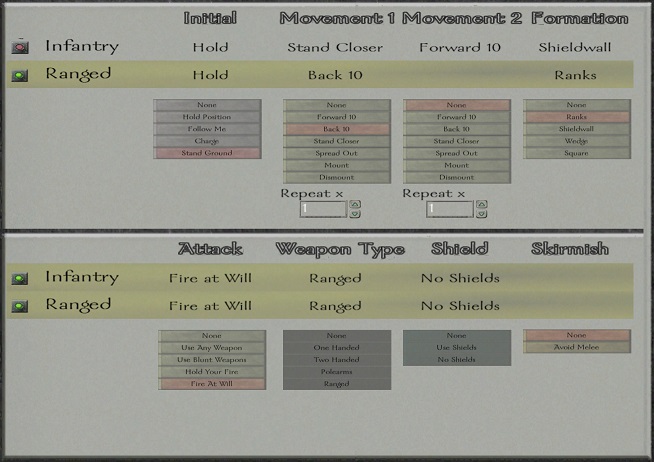
PART V - Courage/Morale
Paradigm Worlds incorporated the "Overhauled Morale and Routing" code written by jacob_hinds. Battles can handle more agents while offering higher FPS.
Each agent gets a constant amount of courage points that defines an agent's morale and bravery. This courage is modified by divisions. (SEE: PHASE 3 - DIVISION MODIFIERS)
Be aware of one feature, however: If a troop is designed as a ranged unit, its courage will go down very fast when engaged in melee combat.
Designed as a ranged unit - what does that entail?
There is a code, called a 'flag', that describes a unit as 'ranged'. If the unit is flagged as 'ranged_guarantee', then it will use ranged weapons for sure. Other trops can use ranged weapons, but it is not guaranteed.
You can speak to each of your troops and ask it if it is ranged or not. In general, all units that are described as "ranged" are flagged as 'ranged_guarantee'. However, if you manually change your troop's division from infantry to ranged, it will make them describe themselves as ranged, but this does not make them 'ranged_guarantee', and vice-versa - changing a ranged unit's division to (for example) infantry does not remove the 'ranged_guarantee' flag.
Ranged units can stand melee fights for only a very short time. Surprised by a cavalry charge, they're going to start running away in just a few seconds time. If enemies pursue them, their withdrawal frmo battle is almost certain.
Troops' courage is replenishnig every few seconds. There is always a chance tha trunning away troops will decide to turn back to battle. This is calculated by the number of fallen comrades. If one side reaches critical amounts of casualties, broken morale causes panic and the battle is almost assuredly lost.
Players can take measures to support morale by using the right ranks. As a general rule, closer ranks means less morale shock. But the closer ranks are, the harder it is to maneuver. It is a commander's responsibility to balance these ranks effectively.
PART VI - Paradigm Worlds Settings and Tweaking Options
You can access, tweak and change Paradigm Worlds and Weather & Warfare Module settings frmo the camp menu.
It is strongly recommended to play a few battles before enforcing any changes.
Options offered by the Paradigm Worlds Weather & Warfare support the following:
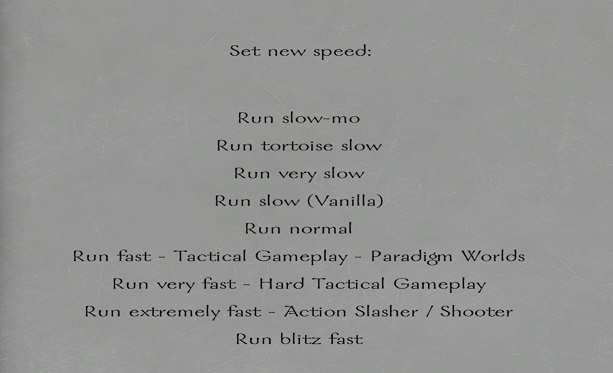
Set Move Speed - By default, it is set to 125% of vanilla speed. Please remember that various weather effects like bad weather, low or high temperature, and terrain affect speed, so effective speed should be close to what you have experienced in the vanilla game.
Changing the agents' speed can have consequences. Faster units will charge at you fastre, giving you less time to prepare yourself for defense or counterattack. You are supposed to set division ranks and to place them in optimal strategic positions before being attacked to avoid unpleasant surprise.
Some armies and factions will apply defensive tactics, but the majority of the so-called 'minor factions' will simply charge at you.
Agents' speed does not affect mounts' speed. Faster agents reduce cavalry importance. You can even tweak agents' speed to the level that they outrun most cavalry untis. High speed will change battle play from a tactical experience to one that is closer to a 'slasher'-type game. It is up to you what kind of challenge you would like to experience.
Set Damage Value - By default, it is set to 120% of vanilla damage. Fighting is a bit more violent than vanilla. Damage dealing ability is also affected by the Weather & Warfare Module.
Due to higher-than-vanilla armor valuse, agents have a limited ability to endanger higher level agents. By setting damage dealing ability to higher values, you will diminihs the difference between units and speed up battles (agents will die faster).
Set Accuracy - Paradigm Worlds' intention is to present a world where ranged weaponry, especially firearms, are powerful, but the least predictable weapon as opposed to how it is in 'our' world. Army commanders cannot afford long term training of their troops. That is why accuracy is lowered by default to 50% of the vanilla value. Remember that each agent's accuracy is modified by the Eagle Eye skill. Ranged units have that skill set to high values, so their accuracy will be better regardless of settings.
Set Auto-Fire Damage - As you are probably aware, Paradigm Worlds is full of machine guns, assault rifles and so on. They are powerful weapons, so to provide some in-game balance their efficiency is reduced by default to 75%.
Set Battlefield Info - There are 3 kinds of Battlefield Info settings. They provide additional information regarding the Weather & Warfare Module. You can be informed about critical hits, weather effects, and special events during battle. You can turn off all additional info and set it to the vanilla feed, set info filters, or let W&W feed you the full set of info.
PART VII - Damage Dealing Techniques
Whenever hits or shots find their targets (in other worsd Are Successful) an additional event triggers. Special code adds or subtracts damage based on the attacker and defender's skills.
a) Vanguard - No matter if it is a ranged shot or melee hit, each agent / troop has a skill that decreases damage. That skill is callde Vanguard.
Each point of the Vanguard skill decreases damage by 2.
Vanguard is enhanced by the Vritniht Microchip. Troops might equip Microchips called Vritniht Vanguard ++VANGUARD. It multiplies the Vanguard skill by 3. In that event the Vanguard skill might raise of the 15-point limit. This means that a troop with 15 Vanguard skill and a specific Microchip can withstand 45 points of damage with no consequence at all.
b) Engineer - This skill increases damage dealt with automatic guns. Each point of the Engineer skill increases damage dealt by 1 point. This rule applies ONLY to automatic guns.
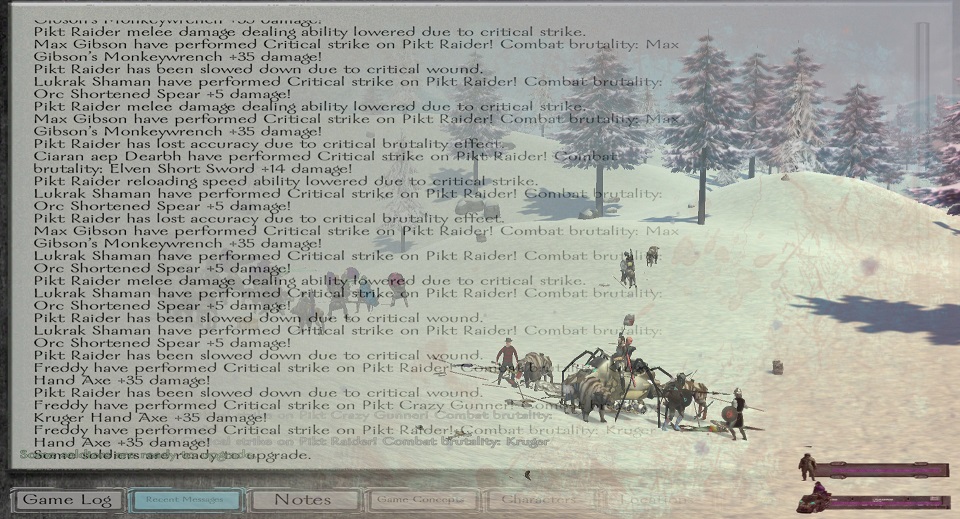
PART VIII - Critical Hits
To provide more drama and RPG flavor, an additional Critical Hit rule has been incorporated into Paradigm Worlds. Critical Hit rules divide to Melee Criticals and Ranged Criticals. They work in a similar way, however they are 'powered' by different skills.A successful critical ranged hit is a balanced combination of various skills. Imagine a skillful hunter or sniper. They have to value direction and strength of wind, weather effects, and the power of their ranged weapon. In seconds, or even fractions of seconds, they have to calculate various elements that combine into a 'master shot'. They need a keen eye to find a weak spot in the enemey's armor. Precision, a sharp eye, experience and agility - these are the attributes of a skilled sniper.
a) Base Chance - Ranged Critical
Build-Up Critical Attack - Attacker Skills and Attributes:
- Weapon Precision x 2
- Eagle Eye
- Professional
- Agility / 6
Build-Up Critical Defense - Defender Skills and Attributes:
- Bodybuilding
- Survival
- Vanguard
- Strength / 6
Critical Attack - Critical Defense = Critical Chance %
Critical Chance is tested against a 100d roll which maens that on each hit the engine 'rolls' a random value from 1 to 100. If Critical Chance < Random Roll = Critical Hit!
Successful Ranged Critical Hit Damage:
In addition to base damage, Critical Damage is calculated using Attacker Skills and Attributes:
- Weapon Precision
- Agility / 2
Furthermore: Critical Effect is applied to a victim. This is common to ranged and melee hits and is described below.
b) Base Chance - Melee Critical
Unlike a Ranged Critical, Critical Strike is more of an effect of an extreme brutality rather than precision. Critical Strike is an effect of enormous power, almost inhumane strength, heroic violence. Imagine a fighter so brutal that they are able to cut through any defense using pure primitive brutal rage. Melee fighting is more a test of brutal barbarian power than swordsmanship finesse.
The test for a Critical Hit is a duel fo two brutal powers, a bit of skill and speed.
Build-Up Critical Attack - Attacker Skills and Attributes:
- Combat Brutality x 2
- Critical Precision
- Combat Speed
- Strength / 4
Build-Up Critical Defense - Defender Skills and Attributes:
- Bodybuilding x 2
- Vanguard x 2
- Strength / 4
Critical Attack - Critical Defense = Critical Chance %
Critical Chance is tested against a 100d roll which means that on each hit the engine 'rolls' a random value from 1 to 100. If Critical Chance < Random Roll = Critical Hit!
Successfull Melee Critical Hit Damage:
In addition to base damage, Critical Damage is calculated using Attacker Skills and Attributes:
- Combat Brutality x 2
- Strength / 2
Furthermore: Critical Effect is applied to a victim. This is common to ranged and melee hits and is described below.
c) Critical Effect - Additional Consequences of a Critical Hit
Critical wounds cause severe damage to an agent's combat ability.
When critically hit, one of 5 events may happen, with an even 20% chance for each.
The victim either:
- Loses half of its speed (movement)
- Loses half of its reloading speed
- Loses half of its melee damage dealing ability
- Loses half of its ranged damage dealing ability
- Loses half of its accuracy
d) Special Rules - Microchips and Books
It has been mntioned that unique Microchips can cause almost guaranteed critical hits. However, there also exist Microchips that guarantee immunity to critical wounds. Immunity will negate any critical effect.
(Warning! The following rules apply to the as-of-yet-unpublished Mod Version 1.30)
Players can also enhance their battlefield abilities by reading specific books. After reading a book, they will be informed on newly gained abilities.
Example: After reading abook titled 'Terror, Torture - Forbidden Knowledge', the player will gain the ability to cause psychic terror to the enemy with each hit. After a successful hit, all enemies within 2 meters will suffer terror resultnig in a small loss to Battle Health.
PART IX - Appendix
This rulebook is a constant work in progress. The Weather & Warfare Module is always being improved based on player input.
The whole set of rules seem very complex, but there's no reason to be discouraged by that. This is merely a detailed description of things that are being calculated automatically by the game's engine. It took several months to construct the whole system and make it work, and yes, that system is very complex, but its advantage is that it is being calculated by a processor, not the player.